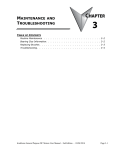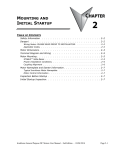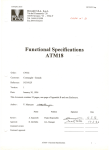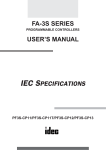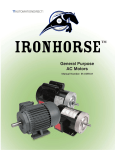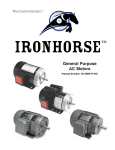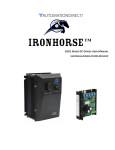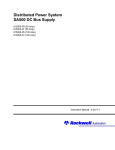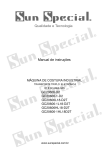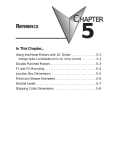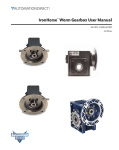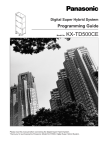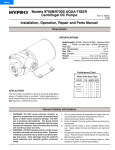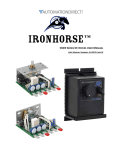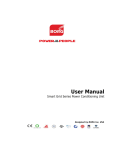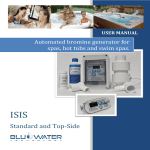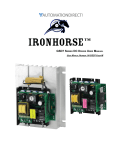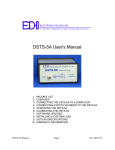Download View / the Complete Manual
Transcript
® General Purpose DC Motors Manual Number: IH-USER-DC-M-WO BLANK PAGE ~ WARNING ~ Thank you for purchasing automation equipment from Automationdirect.com™, doing business as AutomationDirect. We want your new automation equipment to operate safely. Anyone who installs or uses this equipment should read this publication (and any other relevant publications) before installing or operating the equipment. To minimize the risk of potential safety problems, you should follow all applicable local and national codes that regulate the installation and operation of your equipment. These codes vary from area to area and usually change with time. It is your responsibility to determine which codes should be followed, and to verify that the equipment, installation, and operation is in compliance with the latest revision of these codes. At a minimum, you should follow all applicable sections of the National Fire Code, National Electrical Code, and the codes of the National Electrical Manufacturer’s Association (NEMA). There may be local regulatory or government offices that can also help determine which codes and standards are necessary for safe installation and operation. Equipment damage or serious injury to personnel can result from the failure to follow all applicable codes and standards. We do not guarantee the products described in this publication are suitable for your particular application, nor do we assume any responsibility for your product design, installation, or operation. Our products are not fault-tolerant and are not designed, manufactured or intended for use or resale as on-line control equipment in hazardous environments requiring fail-safe performance, such as in the operation of nuclear facilities, aircraft navigation or communication systems, air traffic control, direct life support machines, or weapons systems, in which the failure of the product could lead directly to death, personal injury, or severe physical or environmental damage (“High Risk Activities”). AutomationDirect specifically disclaims any expressed or implied warranty of fitness for High Risk Activities. For additional warranty and safety information, see the Terms and Conditions section of our catalog. If you have any questions concerning the installation or operation of this equipment, or if you need additional information, please call us at 770-844-4200. This publication is based on information that was available at the time it was printed. At AutomationDirect we constantly strive to improve our products and services, so we reserve the right to make changes to the products and/or publications at any time without notice and without any obligation. This publication may also discuss features that may not be available in certain revisions of the product. Trademarks This publication may contain references to products produced and/or offered by other companies. The product and company names may be trademarked and are the sole property of their respective owners. AutomationDirect disclaims any proprietary interest in the marks and names of others. Copyright 2007, 2008, 2009, 2011, 2012, 2014 Automationdirect.com™ Incorporated All Rights Reserved No part of this manual shall be copied, reproduced, or transmitted in any way without the prior, written consent of Automationdirect.com™ Incorporated. AutomationDirect retains the exclusive rights to all information included in this document. ~ AVERTISSEMENT ~ Nous vous remercions d’avoir acheté l’équipement d’automatisation de Automationdirect.com™, en faisant des affaires comme AutomationDirect. Nous tenons à ce que votre nouvel équipement d’automatisation fonctionne en toute sécurité. Toute personne qui installe ou utilise cet équipement doit lire la présente publication (et toutes les autres publications pertinentes) avant de l’installer ou de l’utiliser. Afin de réduire au minimum le risque d’éventuels problèmes de sécurité, vous devez respecter tous les codes locaux et nationaux applicables régissant l’installation et le fonctionnement de votre équipement. Ces codes diffèrent d’une région à l’autre et, habituellement, évoluent au fil du temps. Il vous incombe de déterminer les codes à respecter et de vous assurer que l’équipement, l’installation et le fonctionnement sont conformes aux exigences de la version la plus récente de ces codes. Vous devez, à tout le moins, respecter toutes les sections applicables du Code national de prévention des incendies, du Code national de l’électricité et des codes de la National Electrical Manufacturer’s Association (NEMA). Des organismes de réglementation ou des services gouvernementaux locaux peuvent également vous aider à déterminer les codes ainsi que les normes à respecter pour assurer une installation et un fonctionnement sûrs. L’omission de respecter la totalité des codes et des normes applicables peut entraîner des dommages à l’équipement ou causer de graves blessures au personnel. Nous ne garantissons pas que les produits décrits dans cette publication conviennent à votre application particulière et nous n’assumons aucune responsabilité à l’égard de la conception, de l’installation ou du fonctionnement de votre produit. Nos produits ne sont pas insensibles aux défaillances et ne sont ni conçus ni fabriqués pour l’utilisation ou la revente en tant qu’équipement de commande en ligne dans des environnements dangereux nécessitant une sécurité absolue, par exemple, l’exploitation d’installations nucléaires, les systèmes de navigation aérienne ou de communication, le contrôle de la circulation aérienne, les équipements de survie ou les systèmes d’armes, pour lesquels la défaillance du produit peut provoquer la mort, des blessures corporelles ou de graves dommages matériels ou environnementaux («activités à risque élevé»). La société AutomationDirect nie toute garantie expresse ou implicite d’aptitude à l’emploi en ce qui a trait aux activités à risque élevé. Pour des renseignements additionnels touchant la garantie et la sécurité, veuillez consulter la section Modalités et conditions de notre documentation. Si vous avez des questions au sujet de l’installation ou du fonctionnement de cet équipement, ou encore si vous avez besoin de renseignements supplémentaires, n’hésitez pas à nous téléphoner au 770-844-4200. Cette publication s’appuie sur l’information qui était disponible au moment de l’impression. À la société AutomationDirect, nous nous efforçons constamment d’améliorer nos produits et services. C’est pourquoi nous nous réservons le droit d’apporter des modifications aux produits ou aux publications en tout temps, sans préavis ni quelque obligation que ce soit. La présente publication peut aussi porter sur des caractéristiques susceptibles de ne pas être offertes dans certaines versions révisées du produit. Marques de commerce La présente publication peut contenir des références à des produits fabriqués ou offerts par d’autres entreprises. Les désignations des produits et des entreprises peuvent être des marques de commerce et appartiennent exclusivement à leurs propriétaires respectifs. AutomationDirect nie tout intérêt dans les autres marques et désignations. Copyright 2007, 2008, 2009, 2011, 2012, 2014 Automationdirect.com™ Incorporated Tous droits réservés Nulle partie de ce manuel ne doit être copiée, reproduite ou transmise de quelque façon que ce soit sans le consentement préalable écrit de la société Automationdirect.com™ Incorporated. AutomationDirect conserve les droits exclusifs à l’égard de tous les renseignements contenus dans le présent document. Revision History History H Please include the Manual Number and the Manual Issue, both shown below, when communicating with Technical Support regarding this publication. Manual Number: IH-USER-DC-M-WO Issue: Second Edition Issue Date: 03/04/2014 Issue Date Description of Changes First Edition 02/2010 Original Issue 1st Ed, Rev A 06/2011 Chapter 4: Added accessory brush part # MTPM-BRUSH-3 1st Ed, Rev B 08/2012 Chapter 5: Added motor performance curves and data Publication History Second Edition 03/2014 Added new small-frame PMDC motors IronHorse General Purpose DC Motors User Manual – 2nd Edition – 03/04/2014 Page H–1 Revision History BLANK PAGE Page H–2 IronHorse General Purpose DC Motors User Manual – 2nd Edition – 03/04/2014 Table of Contents Contents Chapter 1: Getting Started Manual Overview������������������������������������������������������������������������������������1–2 Overview of this Publication ���������������������������������������������������������������������������1–2 Who Should Read This Manual������������������������������������������������������������������������1–2 Technical Support������������������������������������������������������������������������������������������1–2 Special Symbols �������������������������������������������������������������������������������������������1–2 Receiving and Inspection�������������������������������������������������������������������������1–2 Unpacking����������������������������������������������������������������������������������������������������1–2 Available Models ������������������������������������������������������������������������������������1–3 IronHorse Motors Part Number Information������������������������������������������������������1–3 Permanent Magnet DC Motors Features and Specifications���������������������������������1–3 Reshipping���������������������������������������������������������������������������������������������1–6 Long Term Storage���������������������������������������������������������������������������������1–6 Warranty������������������������������������������������������������������������������������������������1–6 Chapter 2: Mounting and Initial Startup Safety Information ���������������������������������������������������������������������������������2–2 Danger!�������������������������������������������������������������������������������������������������2–2 Wiring Notes: PLEASE READ PRIOR TO INSTALLATION. ������������������������������������2–2 Applicable Codes�������������������������������������������������������������������������������������������2–2 Motor Dimensions������������������������������������������������������������������������������������2–3 Terminal Diagram and Wiring ������������������������������������������������������������������2–5 Motor Mounting���������������������������������������������������������������������������������������2–5 STABLE™ Slide Bases������������������������������������������������������������������������������������2–5 Proper Installation Conditions�������������������������������������������������������������������������2–6 Coupling Alignment ���������������������������������������������������������������������������������������2–6 Motor Nameplate and Starter Information �������������������������������������������������2–7 Typical IronHorse Motor Nameplate ����������������������������������������������������������������2–7 Motor Control Information������������������������������������������������������������������������������2–7 Inspection Before Startup������������������������������������������������������������������������2–7 Initial Startup Inspection�������������������������������������������������������������������������2–7 IronHorse General Purpose DC Motors User Manual – 2nd Edition – 03/04/2014 TOC–1 Table of Contents Chapter 3: Maintenance and Troubleshooting Routine Maintenance ������������������������������������������������������������������������������3–2 Bearing Size Information�������������������������������������������������������������������������3–2 Replacing Brushes ����������������������������������������������������������������������������������3–3 Troubleshooting �������������������������������������������������������������������������������������3–4 Chapter 4: Accessories STABLE Slide Bases���������������������������������������������������������������������������������4–2 Slide Base Selection���������������������������������������������������������������������������������������4–2 Slide Base Dimensions ����������������������������������������������������������������������������������4–2 Replacement Accessories ������������������������������������������������������������������������4–3 Chapter 5: Reference Junction Box Dimensions for 56C-Frame Motors������������������������������������������5–2 Shipping Crate Dimensions for 56C-Frame Motors���������������������������������������5–2 Decibel Levels for 56C-Frame Motors���������������������������������������������������������5–2 Performance Curves for 56C-Frame Motors������������������������������������������������5–3 MTPM-P33-1L18 �������������������������������������������������������������������������������������������5–3 MTPM-P50-1L18 �������������������������������������������������������������������������������������������5–4 MTPM-P75-1L18 �������������������������������������������������������������������������������������������5–5 MTPM-001-1L18 �������������������������������������������������������������������������������������������5–6 MTPM-1P5-1L18 �������������������������������������������������������������������������������������������5–7 MTPM-P33-1M18�������������������������������������������������������������������������������������������5–8 MTPM-P50-1M18�������������������������������������������������������������������������������������������5–9 MTPM-P75-1M18����������������������������������������������������������������������������������������� 5–10 MTPM-001-1M18����������������������������������������������������������������������������������������� 5–11 MTPM-1P5-1M18����������������������������������������������������������������������������������������� 5–12 MTPM-002-1M18����������������������������������������������������������������������������������������� 5–13 Introduction to Permanent Magnet DC Motors ����������������������������������������� 5–14 Introduction ����������������������������������������������������������������������������������������������� 5–14 Form Factor ����������������������������������������������������������������������������������������������� 5–14 Enclosure and Electrical Insulation Systems���������������������������������������������������� 5–15 Permanent Magnets������������������������������������������������������������������������������������� 5–15 Brushes ����������������������������������������������������������������������������������������������������� 5–16 Power Supply���������������������������������������������������������������������������������������������� 5–17 DC Motor Types������������������������������������������������������������������������������������������� 5–18 Permanent Magnet Motors���������������������������������������������������������������������������� 5–18 Controlling Speed���������������������������������������������������������������������������������������� 5–18 Load Considerations������������������������������������������������������������������������������������� 5–18 High Temperature Considerations ����������������������������������������������������������������� 5–19 Contamination Considerations ���������������������������������������������������������������������� 5–19 Vibration Considerations������������������������������������������������������������������������������� 5–19 Altitude Considerations�������������������������������������������������������������������������������� 5–19 Ambient Temperature���������������������������������������������������������������������������������� 5–20 TOC–2 IronHorse General Purpose DC Motors User Manual – 2nd Edition – 03/04/2014 Getting Started Chapter 1 Table of Contents Manual Overview������������������������������������������������������������������������������������1–2 Overview of this Publication ���������������������������������������������������������������������������1–2 Who Should Read This Manual������������������������������������������������������������������������1–2 Technical Support������������������������������������������������������������������������������������������1–2 Special Symbols �������������������������������������������������������������������������������������������1–2 Receiving and Inspection�������������������������������������������������������������������������1–2 Unpacking����������������������������������������������������������������������������������������������������1–2 Available Models ������������������������������������������������������������������������������������1–3 IronHorse Motors Part Number Information������������������������������������������������������1–3 Permanent Magnet DC Motors Features and Specifications���������������������������������1–3 Reshipping���������������������������������������������������������������������������������������������1–6 Long Term Storage���������������������������������������������������������������������������������1–6 Warranty������������������������������������������������������������������������������������������������1–6 IronHorse General Purpose DC Motors User Manual – 2nd Edition – 03/04/2014 Page 1–1 Chapter 1: Getting Started Manual Overview Overview of this Publication The IronHorse General Purpose DC Motor User Manual describes the installation, maintenance and use of all IronHorse General Purpose DC Motors. Who Should Read This Manual This manual contains important information for those who will install, maintain, use and/or resell any of the IronHorse motors. Technical Support By Telephone: 770-844-4200 (Mon.-Fri., 9:00 a.m.-6:00 p.m. E.T.) On the Web: support.automationdirect.com Our technical support group is glad to work with you in answering your questions. If you cannot find the solution to your particular application, or, if for any reason you need additional technical assistance, please call technical support at 770‑844‑4200. We are available weekdays from 9:00 a.m. to 6:00 p.m. Eastern Time. We also encourage you to visit our web site where you can find technical and non-technical information about our products and our company. Visit us at www.automationdirect.com. Special Symbols When you see the “notepad” icon in the left-hand margin, the paragraph to its immediate right will be a special note. When you see the “exclamation mark” icon in the left-hand margin, the paragraph to its immediate right will be a WARNING. This information could prevent injury, loss of property, or even death (in extreme cases). Receiving and Inspection Unpacking After receiving an IronHorse motor, please check for the following: • Open the motor packaging and inspect for damage during shipment. • Make sure the part number indicated on the motor nameplate corresponds with the part number on your order. • For all 56C-frame motors, make sure that the shipment contains the motor, with attached removable mounting foot and two spare brushes. Motor Nameplate Extra set of brushes (56C motors only) Page 1–2 Mounting foot (not available on all models) IronHorse General Purpose DC Motors User Manual – 2nd Edition – 03/04/2014 Chapter 1: Getting Started Available Models IronHorse Motors Part Number Information MT PM - 1P5 - 1 M 18 Optional Identifier CK: C-face cast iron motor Nominal RPM Two digits representing 100s of rpm Voltage Class (multiple letters possible) A: 115 VAC B: 208-230 VAC D: 460 VAC J: 12 VDC K: 24 VDC L: 90 VDC M: 180 VDC Phase 1: Single phase 3: Three phase Rated Horsepower P: Decimal point # left of P: Rated full hp # right of P: Rated fractional hp (expressed as decimal) Motor type A: Motor accessory C: AC Motor with cast iron frame R: AC Motor with rolled steel frame PM: DC Permanent magnet IronHorse Motors Series Designation Permanent Magnet DC Motors Features and Specifications Small-Frame Permanent Magnet DC (PMDC) Motors IronHorse small-frame PMDC motors are available from 1/31 hp to 1/4 hp. All models have a TENV rolled steel frame. Motors have easy-access brushes. Small-Frame PMDC Motor Specifications Motor Specifications – Small-Frame DC Motors HP Speed (rpm) 1/20 1/10 1/17 1/8 1/13 1/16 1/6 1/4 1/5 1/4 1/31 1746 4252 1825 4224 1841 4290 1732 3996 1854 4375 1797 1/26 1/19 MTPM-P13-1L19 MTPM-P14-1L19 MTPM-P07-1M24 Part Number MTPM-P10-1JK43 MTPM-P13-1JK42 MTPM-P17-1JK43 MTPM-P25-1JK40 MTPM-P25-1JK44 Voltage (VDC) 12 24 12 24 12 24 12 24 12 24 MTPM-P03-1L18 MTPM-P04-1L17 MTPM-P05-1L19 MTPM-P13-1M19 MTPM-P14-1M18 90 180 F.L. Torque (oz·in) F.L. Current (A) 28 4.83 32 5.39 42 7.54 96 80 113 70 18 14.3 12.2 18.1 11.9 0.39 1749 22 0.46 1917 28 0.68 1/8 1917 73 1.4 1/7 1740 86 1.61 1/15 2440 28 0.42 Shaft Dia (in) Pilot Shaft (in) Overhung Load (lb) Wiring Type 0.3125 1.00 85 flying leads Motor Weight (lb) 2.75 3.25 5.3 0.50 2.02 130 junction box 7.8 9 0.3125 1.00 85 flying leads 2.75 3.25 5.3 7.8 0.50 2.02 130 junction box 9 5.3 1/8 1865 73 0.73 7.8 1/7 1828 84 0.83 9 IronHorse General Purpose DC Motors User Manual – 2nd Edition – 03/04/2014 Page 1–3 Chapter 1: Getting Started Rolled Steel 56C Frame Permanent Magnet DC (PMDC) Motors IronHorse 56C frame PMDC motors are available from 1/3 hp to 2hp. All models have a TEFC or TENV rolled steel frame, cast aluminum end bell and removable mounting bases. Motors have easy-access brushes. Rolled Steel 56C Frame PMDC Motor Specifications Motor Specifications – DC 56C Frame Motors – 1800 RPM Part Number HP MTPM-P33-1L18 1/3 MTPM-P50-1L18 1/2 MTPM-P75-1L18 3/4 MTPM-001-1L18 1 MTPM-1P5-1L18 1-1/2 MTPM-P33-1M18 1/3 MTPM-P50-1M18 1/2 MTPM-P75-1M18 3/4 MTPM-001-1M18 1 Base RPM Armature Voltage NEMA Frame Service Factor TENV 90 VDC TEFC 1800 TENV 56C flange mount 1.0 180 VDC TEFC MTPM-1P5-1M18 1-1/2 MTPM-002-1M18 Housing 2 F.L. Amps Motor Weight (lb) Approx Ship Weight (lb) 3.5 17.70 19 5.2 20.74 22 7.8 25.30 27 10.4 28.36 30 15.4 34.97 37 1.75 17.60 19 2.6 20.74 22 3.9 25.58 27 5.2 28.32 30 7.7 35.70 37 9.8 61.95 65 Note: P lease review the AutomationDirect Terms & Conditions for warranty and service on this product. Rolled Steel 56C Frame PMDC Performance Data Efficiency (%) Paint Color Base / Type Overall Speed Range Constant Torque Speed Range Shaft Wire / Housing Ball Bearings Mounting Insulation Class Ambient Temp. ( °C [°F] ) DC Power Form Factor ** Torque (lb·ft) HP Armature Resistance (Ω) Part Number Armature Voltage (VDC) Performance Data * – DC 56C Frame Motors – 1800 RPM MTPM-P33-1L18 1/3 1.85 Full Load 0.97 MTPM-P50-1L18 1/2 1.31 1.46 80 MTPM-P75-1L18 3/4 0.86 2.19 80 MTPM-001-1L18 1 0.67 2.92 80 MTPM-1P5-1L18 1-1/2 1.45 4.38 MTPM-P33-1M18 1/3 7.6 0.97 MTPM-P50-1M18 1/2 5.25 1.46 MTPM-P75-1M18 3/4 MTPM-001-1M18 1 81 Gray Rigid Removable 6203 0-2000 RPM F 90-1800 RPM 40°C (104°F) Keyed 1.35 Junction Box 79 Top Mounted 90 DE ODE 79 80 3.23 2.19 2.63 2.92 80 MTPM-1P5-1M18 1-1/2 1.45 4.38 81 MTPM-002-1M18 1.45 5.84 85 2 180 80 * For performance curves and additional data, refer to Chapter 5: Reference. ** See the discussion of Form Factor in the following section of this chapter. Page 1–4 IronHorse General Purpose DC Motors User Manual – 2nd Edition – 03/04/2014 Chapter 1: Getting Started Permanent Magnet DC Motors Features and Specifications (continued) Form Factor The voltage normally used to power a permanent magnet (PM) DC motor is not pure DC. It is derived by rectifying a supplied AC voltage. The resulting DC voltage has a ripple that is related to the frequency of the AC input, as shown in the example below. Current Fluctuations Cause Ripple Current (Full Wave Rectification) Single Phase AC Rectifier Circuit Rectified DC Form factor is the ratio of Irms to Idc and indicates how close the driving voltage is to pure DC. The form factor for a DC battery is 1.0. The higher the form factor is above 1.0, the more it deviates from pure DC. The Form Factor Table shows examples of commonly used voltages. Form factor should not exceed 1.35 for continuous operation. Half wave rectification is not recommended as it increases form factor. Operating Ironhorse PMDC motors with DC voltages with form factors higher than 1.35 can result in premature brush failure and excessive motor heating. Form Factor Table Form factor DC voltage source 1.0 Battery (pure DC) 1.05 * Pulse width modulation (PWM) 1.35 ** Full wave rectification (single phase) 1.9 *** Half wave rectification (single phase) * All DC-input IronHorse GSD series DC drives are 1.05. IronHorse AC-input GSD5 DC drive is 1.05. ** Single phase full wave rectification is the most common form of DC drive in 0.33–2 hp range. All AC-input IronHorse GSD series DC drives are 1.35 or better. *** Not Recommended. IronHorse General Purpose DC Motors User Manual – 2nd Edition – 03/04/2014 Page 1–5 Chapter 1: Getting Started Reshipping If an IronHorse motor needs to be reshipped from the initial shipping point, the following procedures should be followed to protect the motor from damage. 1) I f the original packaging is to be used for reshipment, inspect the packaging for previous shipping damage and repackage if necessary. Take care to protect the motor body, fan cover and shaft. 2) I t is a good idea to bolt or strap the motor to a platform that fits securely in the bottom of the shipping crate or box. This helps prevent the motor from shifting during transport and thus protects the bearings from damage. Long Term Storage The following preventative measures should be taken when storing IronHorse motors for a long period of time. 1) S tore motors in a controller temperature, dry atmosphere free of excess dirt, dust and airborne particles. 2) Rotate the motor shaft every sixty days to prevent hardening of the bearing grease. Warranty IronHorse 56C-frame PMDC motors carry a two year warranty from the date of invoice, and the small-frame PMDC motors carry our standard one year warranty. Page 1–6 IronHorse General Purpose DC Motors User Manual – 2nd Edition – 03/04/2014 Mounting and Initial Startup Chapter 2 Table of Contents Safety Information ���������������������������������������������������������������������������������2–2 Danger!�������������������������������������������������������������������������������������������������2–2 Wiring Notes: PLEASE READ PRIOR TO INSTALLATION. ������������������������������������2–2 Applicable Codes�������������������������������������������������������������������������������������������2–2 Motor Dimensions������������������������������������������������������������������������������������2–3 Terminal Diagram and Wiring ������������������������������������������������������������������2–5 Motor Mounting���������������������������������������������������������������������������������������2–5 STABLE™ Slide Bases������������������������������������������������������������������������������������2–5 Proper Installation Conditions�������������������������������������������������������������������������2–6 Coupling Alignment ���������������������������������������������������������������������������������������2–6 Motor Nameplate and Starter Information �������������������������������������������������2–7 Typical IronHorse Motor Nameplate ����������������������������������������������������������������2–7 Motor Control Information������������������������������������������������������������������������������2–7 Inspection Before Startup������������������������������������������������������������������������2–7 Initial Startup Inspection�������������������������������������������������������������������������2–7 IronHorse General Purpose DC Motors User Manual – 2nd Edition – 03/04/2014 Page 2–1 Chapter 2: Mounting and Initial Startup Safety Information Danger! Hazardous Voltage! Before making any connection to the motor, disconnect all power to the motor. Warning: Any electrical or mechanical modification to this equipment without prior written consent of AutomationDirect.com, Inc. will void all warranties, may result in a safety hazard, and may void the cCSAus listing. Warning: To avoid physical injury, keep your hands and clothing away from all moving parts. Wiring Notes: PLEASE READ PRIOR TO INSTALLATION. 1) During installation, follow all local electrical, construction, and safety codes for the country in which the motor is to be installed. 2) Make sure the appropriate protective devices (circuit breaker or fuses) are connected between the power source and motor controller. 3) Make sure that the leads are connected correctly and the motor is properly grounded. (Ground resistance should not exceed 0.1Ω.) 4) Use ground leads that comply with AWG/MCM standards and keep them as short as possible. 5) Make sure that the power source is capable of supplying the correct voltage and required current to the motor. 6) Do not attach or remove wiring when power is applied to the motor. Applicable Codes Small-Frame Motors All IronHorse small-frame PMDC motors are UL recognized (E365956) and CSA approved. Therefore they comply with the requirements of the National Electrical Code (NEC) and the Canadian Electrical Code (CEC). Installations intended to meet the UL or CSA requirements must follow the instructions provided in the “Wiring Notes” as a minimum standard. Follow all local codes that exceed UL or CSA requirements. Refer to the technical data on the motor nameplate for electrical and performance data. IronHorse small-frame PMDC motors are RoHS compliant. 56C-Frame motors All IronHorse 56C-frame PMDC motors are cCSAus listed, and therefore comply with the requirements of the National Electrical Code (NEC) and the Canadian Electrical Code (CEC). Installations intended to meet the cCSAus requirements must follow the instructions provided in the “Wiring Notes” as a minimum standard. Follow all local codes that exceed cCSAus requirements. Refer to the technical data on the motor nameplate for electrical and performance data. IronHorse 56C-frame PMDC motors are CE compliant. Page 2–2 IronHorse General Purpose DC Motors User Manual – 2nd Edition – 03/04/2014 Chapter 2: Mounting and Initial Startup Motor Dimensions ( Dimensions = in [mm] ) Small-Frame TENV DC Motors with 0.3125-inch Shaft Diameter – Dimensions MTPMP03-1L18, P10-1JK34 P04-1L17, P13-1JK42 L1 4.44 [112.8] 4.94 [125.5] L2 4.19 [106.4] 4.69 [119.1] Small-Frame TENV DC Motors with 0.50-inch Shaft Diameter – Dimensions MTPMP05-1L19, P07-1M24, P17-JK43 P13-1L19, P13-1M19, P25-1JK40 P14-1L19, P14-1M18, P25-1JK44 L1 4.92 [125.0] 6.92 [175.8] 7.92 [201.2] L2 4.56 [115.8] 6.46 [164.1] 7.46 [189.5] IronHorse General Purpose DC Motors User Manual – 2nd Edition – 03/04/2014 Page 2–3 Chapter 2: Mounting and Initial Startup Motor Dimensions (continued) ( Dimensions = in [mm] ) 56C-Frame TENV DC Motor – 0.33 to 0.5 hp – Dimensions 56C-Frame TEFC DC Motor – 0.75 to 1.5 hp – Dimensions 56C-Frame TEFC DC Motor – 2hp – Dimensions Page 2–4 IronHorse General Purpose DC Motors User Manual – 2nd Edition – 03/04/2014 Chapter 2: Mounting and Initial Startup Terminal Diagram and Wiring DC motors are very easy to wire. There are only two terminals; one for the positive (red) lead and one for the negative (black) lead. If wired correctly, the motor will turn clockwise when you are facing the motor shaft. If the motor turns counterclockwise, reverse the positive and negative leads. + M NOTE: These motors do not have connectors for installing encoders or tachometers. Motor Mounting IronHorse motors should be properly mounted to prevent premature motor and/or bearing failure. There are no limitations on mounting orientation; that is, the motor can be installed vertically, horizontally, upside down, or at any angle. When necessary, use motor shims to level the motor at all mounting bolt holes. Use proper diameter bolts of the highest grade material available for the application. Use the chart below to select the correct size bolt for each frame size. A mounted motor must operate vibration free. Each motor installation should be checked for potential vibration situations. Base shims should also be used when necessary for level mounting. Motor Mounting Bolt Sizes Frame Size Bolt Diameter Small Frame 56 Minimum Usable Thread Length (A) Minimum Exposed Anchor Length (B) A B Face mounting only; no mounting feet 5/16 in 0.45 in 0.88 in STABLE™ Slide Bases AutomationDirect offers STABLE slide bases for simple mounting of NEMA standard frame motors. STABLE slide bases are manufactured from heavy-duty steel and allow motor position adjustment when mounting any NEMA framed motor. See Chapter 4 (Accessories) for complete details. IronHorse General Purpose DC Motors User Manual – 2nd Edition – 03/04/2014 Page 2–5 Chapter 2: Mounting and Initial Startup Proper Installation Conditions Small-Frame motors IronHorse small-frame motors should be properly mounted to prevent premature motor and/ or bearing failure. There are no limitations on mounting orientation; that is, the motor can be installed vertically, horizontally, upside down, or at any angle. Use proper diameter bolts of the highest grade material available for the application, as shown on the dimension diagrams. A mounted motor must operate vibration free. Each motor installation should be checked for potential vibration situations. 56C-Frame Motors Care should be taken to make sure that an IronHorse 56C-frame motor is mounted at least thirty inches from a wall or structure that would prevent proper ventilation of the motor. The installation area should be free of dust and smoke particles. Any air contaminate could inhibit proper operation of the motor fan. If an IronHorse motor is to be installed in a high altitude or in a low temperature location, use the Altitude / Ambient Temperature Derating chart below for proper motor sizing. Altitude / Ambient Temperature Derating Chart Altitude – Meters (Feet) Above Sea Level 1000 (3281) 1500 (4921) 2000 (6562) 2500 (8202) 3000 (9842) 3500 (11,483) Temperature – °C (°F) 10 (50) 4000 (13,123) 1.50 15 (59) 1.05 0.99 1.05 0.99 0.93 1.05 0.98 0.93 0.88 1.05 0.97 0.92 0.87 0.82 20 (68) 25 (77) 30 (86) 40 (104) 1.00 0.94 0.89 0.85 0.80 0.76 0.72 50 (122) 0.85 0.80 0.76 0.72 0.68 0.65 0.62 60 (140) 0.71 0.67 0.64 0.60 0.57 0.55 0.52 Example:1hp @ 60 °C and 2000 meters 1 / 0.64 = 1.56 hp The motor should be a 2hp motor. Coupling Alignment Correct coupling alignment is very important to the life of the motor. Coupling misalignment is the major cause of motor bearing failure. In belt driven applications, pulleys should be installed correctly. Belt tension, alignment and wear should be checked at installation and at regular maintenance intervals. Install motor couplings per the manufacturers instructions. Whenever possible, direct couple or flange mount IronHorse motors in their application. Doing so can greatly extend the bearing life. Page 2–6 IronHorse General Purpose DC Motors User Manual – 2nd Edition – 03/04/2014 Chapter 2: Mounting and Initial Startup Motor Nameplate and Starter Information Typical IronHorse Motor Nameplate Small-Frame Motor Nameplate 56C-Frame Motor Nameplate Motor Control Information Starting System Information Frame Size Number of Internal Leads Internal Lead Size Internal Lead Length Voltage Small-Frame 2 16 AWG 6 in (with junction box) 18 (without junction box) 12–24/90/180 VDC 56C (1Ø) 2 16 AWG 6 in 90/180 VDC DC Motor Type Permanent Magnet Inspection Before Startup 1) Turn the shaft by hand and make sure the shaft turns freely. Listen for any unusual noises and feel for any interruption in the shaft as it turns. 2) Perform a final check on the installation of all parts in the assembly. Check the motor mounting bolts, coupling, belt drive, C-face mount, alignment, etc. 3) Verify all electrical connections for the motor and drive. Make sure all terminal screws are tightened properly. 4) Make sure that all electrical components used in the installation are rated for the locked rotor amperage. 5) Make sure the motor is properly grounded. Use the grounding lug provided in the motor terminal box. Initial Startup Inspection 1) At initial startup monitor the start-up voltage and the running voltage of the motor. The full load voltage should never exceed the line voltage on the motor nameplate multiplied by the service factor of the motor. Example: 180 VDC x 1.00 = 180 VDC. 2) Check the full load running amperage of the motor. The full load running amperage should not be more than the amount indicated on the motor nameplate 3) Listen for any unusual noises at motor start-up and in the first hour of operation. Listen for any unusual bearing noise in the drive end and opposite drive end of the motor. Abnormal bearing noise can be an indication of a defective bearing. Ironhorse PMDC motors have sealed bearings. IronHorse General Purpose DC Motors User Manual – 2nd Edition – 03/04/2014 Page 2–7 Chapter 2: Mounting and Initial Startup BLANK PAGE Page 2–8 IronHorse General Purpose DC Motors User Manual – 2nd Edition – 03/04/2014 Maintenance and Troubleshooting Chapter 3 Table of Contents Routine Maintenance ������������������������������������������������������������������������������3–2 Bearing Size Information�������������������������������������������������������������������������3–2 Replacing Brushes ����������������������������������������������������������������������������������3–3 Troubleshooting �������������������������������������������������������������������������������������3–4 IronHorse General Purpose DC Motors User Manual – 2nd Edition – 03/04/2014 Page 3–1 Chapter 3: Maintenance and Troubleshooting Routine Maintenance A routine maintenance schedule should be developed for every IronHorse motor installation based on the individual application. Motors installed in a harsh running environment should be serviced more frequently than those installed in a clean, climate controlled area. The following list should be used as a basis for creating the routine maintenance schedule. 1) Clean the motor housing using a brush, soft cloth or compressed air. Remove any dirt and dust from the fan and fan cover vents. 2) Frequently monitor the bearing temperature on the motor. It should not exceed 60°C (140°F). 3) Have the insulation checked periodically by an authorized motor specialist. 4) Replace the motor brushes after every 2500 hours of operation. Bearing Size Information Bearing Chart Frame Size Drive End Bearing SKF Type Small-Frame 56C Opposite Drive End Bearing SKF Type not user serviceable 6203 6203 All IronHorse 56C-frame motors use premium sealed SKF brand bearings. Page 3–2 IronHorse General Purpose DC Motors User Manual – 2nd Edition – 03/04/2014 Chapter 3: Maintenance and Troubleshooting Replacing Brushes Warning: To prevent serious personal injury and damage to your equipment, always disconnect input power before replacing brushes. A spare set of brushes ship in each 56C-frame PMDC motor box, and the brushes should be replaced after every 2500 hours of operation. Small-frame PMDC motor brushes should be replaced as needed. If you visually inspect the brushes, the minimum acceptable length is 6mm. See “Chapter 4: Accessories” for replacement brush ordering information. Make sure you install the correct replacement brushes; check the part numbers carefully. Ensure that the replacement brushes are the same width as the brushes being removed from the motor. DO NOT install smaller brushes in a larger motor. There is no break-in period with new brushes. Replacement brush and spring assembly sets: NOTE: The brushes are spring-loaded. brush cover. Be careful when removing the Motor has two brushes; one on each side of the motor. Always replace the brushes in pairs. 1) Remove the brush cover using a flathead screwdriver as shown. Turn the brush cover counterclockwise to remove. 2) Carefully remove the old brush and spring assembly and install the replacement. 3) Reinstall the brush cover, turning clockwise. 4) Replace the other motor brush and spring following the same steps. IronHorse General Purpose DC Motors User Manual – 2nd Edition – 03/04/2014 Page 3–3 Chapter 3: Maintenance and Troubleshooting Troubleshooting To prevent serious damage, faults observed when a motor first goes into service or during subsequent operation should be investigated and repaired immediately. These troubleshooting tables cover most common PMDC motor problems. Warning: To prevent serious personal injury and damage to your equipment, always disconnect input power before inspecting or repairing your motor. Mechanical Problems – Noise While Running Problem Motor vibrates or runs noisily when coupled up, but runs okay when uncoupled. Motor runs rough when uncoupled. Possible Causes Solutions Defective transmission components, or problem with the machine being driven. Inspect transmission and drive components. Check alignment. Foundation has become unlevel. Realign machine set. Check and repair foundation level. Problem with gear drive. Align drive, check driving and driven gear pitch circles. Incorrectly balanced drive or driven machine components. Re-balance drive and/or driven components. Bearing damage. See Bearing Problems troubleshooting table. Mounting bolts are loose. Re-tighten and lock mounting bolts. Fitted drive components (coupling or pulleys) affecting rotor balance. Balance rotor with coupling or pulley fitted. Mechanical Problems – Roller Bearing Problems Problem Possible Causes Solutions Scratching, rubbing, or rumbling noise Bearing is defective. from bearing. Replace bearing. * Bearing has run dry. Replace bearing. * Faulty cage. Replace bearing. * Bearing overloaded. Check alignment, belt tension, gear pressure, coupling thrust. Reduce bearing load. If needed, reduce additional axial load. Whistling noise from bearing. Excessive bearing wear. Scoring when motor Bearing is being subjected to vibration is inoperative. from outside source. Isolate motor from source of vibration or keep motor turning over. Scoring when motor Current leakage. running. Remove motor from service. Repair or replace motor. * Bearings in the small-frame PMDC motors are not user replaceable; replace motor instead of bearings. Page 3–4 IronHorse General Purpose DC Motors User Manual – 2nd Edition – 03/04/2014 Chapter 3: Maintenance and Troubleshooting Troubleshooting (continued) Electrical Problems Problem Possible Causes Motor shaft rotates in wrong Positive (+) and negative direction (should rotate (-) input power leads are clockwise when facing reversed. shaft). Motor fails to start off-load. Jerky starting. Motor will not run under load. Motor overspeeding and hunting while under load. Motor overheating. Solutions Switch the input power connections. Break in the armature supply. Check and repair connection. Fuse is blown. Replace fuse. Controller damaged or incorrectly connected. Check starter for break in circuit and repair break. Armature coils burned out or short-circuiting. Correct short circuit. This may require bringing the motor to a repair shop. Brushes not bearing down correctly. Check brush position and bearing pressure. Replace worn brushes. Break in starter circuit. Repair break. Armature short-circuit. Correct short circuit. This may require bringing the motor to a repair shop. Commutator short-circuit. Check commutator and repair short-circuit. Short circuit in the supply. Locate short circuit and repair. Overloading. Check current input and remedy overload. Voltage drop. Increase supply line cross section. Controller. Decrease IR compensation. Check speed potentiometer wiring and signal, and repair if needed. Overloading. Check voltage and current levels, and correct overload condition. Insufficient airflow. Improve cooling conditions. Cooling air temperature too high. If TEFC model, inspect the fan for damage. Armature winding short-circuit. Check windings and soldered connections. Repair coils or windings. IronHorse General Purpose DC Motors User Manual – 2nd Edition – 03/04/2014 Page 3–5 Chapter 3: Maintenance and Troubleshooting BLANK PAGE Page 3–6 IronHorse General Purpose DC Motors User Manual – 2nd Edition – 03/04/2014 Accessories Chapter 4 Table of Contents STABLE Slide Bases���������������������������������������������������������������������������������4–2 Slide Base Selection���������������������������������������������������������������������������������������4–2 Slide Base Dimensions ����������������������������������������������������������������������������������4–2 Replacement Accessories ������������������������������������������������������������������������4–3 IronHorse General Purpose DC Motors User Manual – 2nd Edition – 03/04/2014 Page 4–1 Chapter 4: Accessories STABLE Slide Bases AutomationDirect offers STABLE motor slide bases for mounting NEMA motor frame sizes from 56 to 449. These heavy-duty steel bases are primed with an oven-baked primer ready for painting. The motor mounting bolts are welded to the exact motor foot pattern to prevent the bolts from spinning. The motor position is adjustable along the long axis. Slide Base Selection Motor Slide Bases Part Number Fits Frame Type Shipping Weight (lb) IronHorse Model 56 3.5 MTPM-xxx-1L18 MTPM-xxx-1M18 MTA-BASE-W56 Slide Base Dimensions L H F B J D F N H M G E E A I G K(mm) C W56 - W145T Motor Slide Base Dimensions Dimensions [inches, except as noted] – STABLE Motor Slide Bases MTA-BASE-Wxxxx A B C D E F G 56 10-5/8 6-1/2 1-1/8 4-1/2 2-7/16 1-1/2 3-13/16 Dimensions [inches, except as noted] – STABLE Motor Slide Bases (continued) Page 4–2 MTA-BASE-Wxxxx H I J K (mm) L M N 56 2-7/8 3/8 3 2 mm 7/8 5/16 x 1 3/8 x 4 IronHorse General Purpose DC Motors User Manual – 2nd Edition – 03/04/2014 Chapter 4: Accessories Replacement Accessories Replacement brushes and spare/replacement parts can be ordered at www.automationdirect.com. Replacement DC Motor Brushes All small-frame IronHorse® DC motors ship with brushes installed, and the brushes should be replaced as needed. (Minimum brush length is 6mm.) Brushes for 56C-frame motors should be changed after every 2500 hours of use. Each 56C-frame motor ships with brushes installed, plus one extra set of spare/replacement brushes. Match the replacement brush part number against the motor horsepower carefully to insure you order the correct brushes for your motor. When replacing brushes, pay special attention that the correct brush is inserted into the motor (especially if you have multiple motor sizes at your facility). Verify that the width of the brush you remove matches the width of the replacement brush. DO NOT install smaller brushes into a larger motor. See “Chapter 3: Maintenance and Troubleshooting” for brush replacement procedure. DC Motor Replacement Brushes Part Number Description MTPM-BRUSH-1 MTPM-BRUSH-2 Motor Type Brushes with springs (one set of 2) MTPM-BRUSH-3 MTPM-BRUSH-4 MTPM-BRUSH-5 MTPM-BRUSH-6 Brushes with springs and caps (one set of 2) MTPM-BRUSH-7 IronHorse MTPM Rated Voltage Motor HP 90 VDC 180 VDC 0.33–1 180 VDC 1.5–2 hp 90 VDC 1.5 hp 12/24 VDC 1/4 @ 24VDC 1/10–1/6 @ 24VDC 90VDC 180VDC 1/8–1/7 @ 90VDC 1/8–1/7 @ 180VDC 90VDC 180VDC 1/31–1/19 @ 90VDC 1/15 @ 180VDC Brush Materials Resin class Graphite Copper Graphite Carbon Graphite All IronHorse DC motors ship with one set of brushes installed. All IronHorse 56C-frame DC motors ship with one set of brushes installed and one extra set in the box. Spare/Replacement Parts Kit for Small-Frame DC Motors Small-Frame DC Motors Spare Parts Kit Part Number Description MTGA-KIT-1 For Motors MTPM- DC motor spare parts kit, for certain MTPM series permanent P05-1L19, P13-1L19, P14-1L19; magnet DC motors as listed. P17-1JK43, P25-1JK40, P25-1JK44; Includes: two metal brush cap covers, one terminal box, one Pxx-1Mxx 1/8 (0.125 inch) shaft key, and one 3/16 (0.187 inch) shaft key. MTGA-KIT-1 includes spare/replacement parts only. All parts in the kit are included with the applicable motors. IronHorse General Purpose DC Motors User Manual – 2nd Edition – 03/04/2014 Page 4–3 Chapter 4: Accessories BLANK PAGE Page 4–4 IronHorse General Purpose DC Motors User Manual – 2nd Edition – 03/04/2014 Reference Chapter 5 Table of Contents Junction Box Dimensions for 56C-Frame Motors������������������������������������������5–2 Shipping Crate Dimensions for 56C-Frame Motors���������������������������������������5–2 Decibel Levels for 56C-Frame Motors���������������������������������������������������������5–2 Performance Curves for 56C-Frame Motors������������������������������������������������5–3 MTPM-P33-1L18 �������������������������������������������������������������������������������������������5–3 MTPM-P50-1L18 �������������������������������������������������������������������������������������������5–4 MTPM-P75-1L18 �������������������������������������������������������������������������������������������5–5 MTPM-001-1L18 �������������������������������������������������������������������������������������������5–6 MTPM-1P5-1L18 �������������������������������������������������������������������������������������������5–7 MTPM-P33-1M18�������������������������������������������������������������������������������������������5–8 MTPM-P50-1M18�������������������������������������������������������������������������������������������5–9 MTPM-P75-1M18����������������������������������������������������������������������������������������� 5–10 MTPM-001-1M18����������������������������������������������������������������������������������������� 5–11 MTPM-1P5-1M18����������������������������������������������������������������������������������������� 5–12 MTPM-002-1M18����������������������������������������������������������������������������������������� 5–13 Introduction to Permanent Magnet DC Motors ����������������������������������������� 5–14 Introduction ����������������������������������������������������������������������������������������������� 5–14 Form Factor ����������������������������������������������������������������������������������������������� 5–14 Enclosure and Electrical Insulation Systems���������������������������������������������������� 5–15 Permanent Magnets������������������������������������������������������������������������������������� 5–15 Brushes ����������������������������������������������������������������������������������������������������� 5–16 Power Supply���������������������������������������������������������������������������������������������� 5–17 DC Motor Types������������������������������������������������������������������������������������������� 5–18 Permanent Magnet Motors���������������������������������������������������������������������������� 5–18 Controlling Speed���������������������������������������������������������������������������������������� 5–18 Load Considerations������������������������������������������������������������������������������������� 5–18 High Temperature Considerations ����������������������������������������������������������������� 5–19 Contamination Considerations ���������������������������������������������������������������������� 5–19 Vibration Considerations������������������������������������������������������������������������������� 5–19 Altitude Considerations�������������������������������������������������������������������������������� 5–19 Ambient Temperature���������������������������������������������������������������������������������� 5–20 IronHorse General Purpose DC Motors User Manual – 2nd Edition – 03/04/2014 Page 5–1 Chapter 5: Reference Junction Box Dimensions for 56C-Frame Motors XC (Length) AA (Conduit Hole Diameter) XD (Width) HH (Depth) Junction Box Dimensions Frame Size XD Width XC Length HH Depth AA Conduit Hole (NPT) 56 2.5 in 2.76 in 1.55 in 1/2 in Shipping Crate Dimensions for 56C-Frame Motors Nominal Shipping Crate Dimensions Frame Size HP Width x Depth x Height (in) 1/3 13.2 x 7.5 x 8.5 1/2 56C 3/4 15.2 x 7.5 x 8.5 1 15.9 x 7.5 x 8.5 1-1/2 18.1 x 7.5 x 8.5 2 18.7 x 9.8 x 10.6 Motor and shipping weights are listed in the Motor Specifications tables in “Chapter 1: Getting Started.” Decibel Levels for 56C-Frame Motors The decibel (sound) level of an IronHorse PMDC motor should be measured after initial startup, after 30 days, and after six months of use. Decibel levels should remain fairly consistent, and can be an indication of misalignment and premature bearing wear. If the measured decibel level for your IronHorse model exceeds the value listed below by more than 10%, contact AutomationDirect or a local motor service technician found at www.easa.com. Average Decibel Levels Page 5–2 Frame Size HP Noise Level: Lw dB (A) 56 All 55.0 IronHorse General Purpose DC Motors User Manual – 2nd Edition – 03/04/2014 Chapter 5: Reference Performance Curves for 56C-Frame Motors MTPM-P33-1L18 Performance Data – MTPM-P33-1L18 Description U (V) I (A) P1 (W) M (N·m) n (rpm) P2 (W) Eff No Load 90.23 0.850 76.71 0.083 1828 15.92 20.7 Rated 90.07 3.752 337.9 1.422 1678 250.0 73.9 Max Eff 90.03 4.680 421.4 1.869 1630 319.9 75.6 Max Pout 89.91 8.502 764.4 3.640 1435 546.9 71.5 Max Torque 89.91 8.502 764.4 3.640 1435 546.9 71.5 End 89.91 8.502 764.4 3.640 1435 546.9 71.5 IronHorse General Purpose DC Motors User Manual – 2nd Edition – 03/04/2014 Page 5–3 Chapter 5: Reference Performance Curves (continued) MTPM-P50-1L18 Performance Data – MTPM-P50-1L18 Description Page 5–4 U (V) I (A) P1 (W) M (N·m) n (rpm) P2 (W) Eff No Load 90.67 0.690 62.60 0.077 1896 15.40 24.6 Rated 90.40 5.146 465.3 2.115 1693 375.0 80.5 81.0 Max Eff 90.41 5.067 458.1 2.092 1696 371.4 Max Pout 90.30 8.576 774.5 3.684 1551 598.3 77.2 Max Torque 90.30 8.576 774.5 3.684 1551 598.3 77.2 End 90.30 8.576 774.5 3.684 1551 598.3 77.2 IronHorse General Purpose DC Motors User Manual – 2nd Edition – 03/04/2014 Chapter 5: Reference Performance Curves (continued) MTPM-P75-1L18 Performance Data – MTPM-P75-1L18 Description U (V) I (A) P1 (W) M (N·m) n (rpm) P2 (W) Eff No Load 90.44 0.615 55.68 0.071 1833 13.66 24.5 Rated 90.11 7.519 677.5 3.244 1619 550.0 81.1 Max Eff 90.17 5.634 508.1 2.383 1673 417.4 82.1 Max Pout 90.05 9.803 882.8 4.313 1555 702.2 79.5 Max Torque 90.05 9.803 882.8 4.313 1555 702.2 79.5 End 90.05 9.803 882.8 4.313 1555 702.2 79.5 IronHorse General Purpose DC Motors User Manual – 2nd Edition – 03/04/2014 Page 5–5 Chapter 5: Reference Performance Curves (continued) MTPM-001-1L18 Performance Data – MTPM-001-1L18 Description Page 5–6 U (V) I (A) P1 (W) M (N·m) n (rpm) P2 (W) Eff No Load 90.67 0.816 73.99 0.082 1887 16.35 22.1 Rated 90.30 10.16 918.4 4.345 1647 750.0 81.6 82.5 Max Eff 90.34 8.131 734.6 3.418 1694 606.2 Max Pout 90.30 10.21 922.2 4.364 1647 752.9 81.6 Max Torque 90.30 10.21 922.2 4.364 1647 752.9 81.6 End 90.30 10.21 922.2 4.364 1647 752.9 81.6 IronHorse General Purpose DC Motors User Manual – 2nd Edition – 03/04/2014 Chapter 5: Reference Performance Curves (continued) MTPM-1P5-1L18 Performance Data – MTPM-1P5-1L18 Description U (V) I (A) P1 (W) M (N·m) n (rpm) P2 (W) Eff No Load 90.51 0.852 77.18 0.086 1917 17.42 22.5 Rated 90.01 14.75 1328 6.373 1686 1125 84.7 Max Eff 90.13 9.510 857.2 3.992 1765 737.8 86.0 Max Pout 89.77 25.07 2251 11.110 1537 1787 79.4 Max Torque 89.77 25.07 2251 11.110 1537 1787 79.4 End 89.77 25.07 2251 11.110 1537 1787 79.4 IronHorse General Purpose DC Motors User Manual – 2nd Edition – 03/04/2014 Page 5–7 Chapter 5: Reference Performance Curves (continued) MTPM-P33-1M18 Performance Data – MTPM-P33-1M18 Description Page 5–8 U (V) I (A) P1 (W) M (N·m) n (rpm) P2 (W) Eff No Load 180.6 0.375 67.90 0.076 1966 15.64 23.0 Rated 180.5 1.980 357.5 1.414 1687 250.0 69.9 69.9 Max Eff 180.5 1.980 357.5 1.414 1687 250.0 Max Pout 180.4 2.744 495.2 2.046 1573 337.0 68.0 Max Torque 180.4 2.744 495.2 2.046 1573 337.0 68.0 End 180.4 2.744 495.2 2.046 1573 337.0 68.0 IronHorse General Purpose DC Motors User Manual – 2nd Edition – 03/04/2014 Chapter 5: Reference Performance Curves (continued) MTPM-P50-1M18 Performance Data – MTPM-P50-1M18 Description U (V) I (A) P1 (W) M (N·m) n (rpm) P2 (W) Eff No Load 180.2 0.391 70.66 0.106 1905 21.22 30.0 Rated 180.1 2.554 460.2 2.044 1752 375.0 81.4 Max Eff 180.0 2.812 506.4 2.278 1734 413.6 81.6 Max Pout 180.0 3.142 565.9 2.571 1710 460.4 81.3 Max Torque 180.0 3.142 565.9 2.571 1710 460.4 81.3 End 180.0 3.142 565.9 2.571 1710 460.4 81.3 IronHorse General Purpose DC Motors User Manual – 2nd Edition – 03/04/2014 Page 5–9 Chapter 5: Reference Performance Curves (continued) MTPM-P75-1M18 Performance Data – MTPM-P75-1M18 Description Page 5–10 U (V) I (A) P1 (W) M (N·m) n (rpm) P2 (W) Eff No Load 180.8 0.333 60.35 0.081 1858 15.87 26.3 Rated 180.5 3.547 640.7 3.081 1704 550.0 85.8 86.3 Max Eff 180.6 3.164 571.4 2.736 1722 493.3 Max Pout 180.5 4.272 771.4 3.766 1672 659.3 85.4 Max Torque 180.5 4.272 771.4 3.766 1672 659.3 85.4 End 180.5 4.272 771.4 3.766 1672 659.3 85.4 IronHorse General Purpose DC Motors User Manual – 2nd Edition – 03/04/2014 Chapter 5: Reference Performance Curves (continued) MTPM-001-1M18 Performance Data – MTPM-001-1M18 Description U (V) I (A) P1 (W) M (N·m) n (rpm) P2 (W) Eff No Load 180.6 0.434 78.52 0.075 1792 14.10 17.9 Rated 180.4 5.026 909.7 4.412 1623 750.0 82.4 Max Eff 180.4 5.026 909.7 4.412 1623 750.0 82.4 Max Pout 180.4 5.026 909.7 4.412 1623 750.0 82.4 Max Torque 180.4 5.026 909.7 4.412 1623 750.0 82.4 End 180.4 5.026 909.7 4.412 1623 750.0 82.4 IronHorse General Purpose DC Motors User Manual – 2nd Edition – 03/04/2014 Page 5–11 Chapter 5: Reference Performance Curves (continued) MTPM-1P5-1M18 Performance Data – MTPM-1P5-1M18 Description Page 5–12 U (V) I (A) P1 (W) M (N·m) n (rpm) P2 (W) Eff No Load 180.3 0.492 88.87 0.084 1927 17.02 19.1 Rated 180.0 7.198 1296 6.099 1761 1125 86.8 86.9 Max Eff 180.1 5.337 961.5 4.427 1804 836.2 Max Pout 179.8 14.40 2590 12.261 1612 2069 79.8 Max Torque 179.8 14.40 2590 12.261 1612 2069 79.8 End 179.8 14.40 2590 12.261 1612 2069 79.8 IronHorse General Purpose DC Motors User Manual – 2nd Edition – 03/04/2014 Chapter 5: Reference Performance Curves (continued) MTPM-002-1M18 Performance Data – MTPM-002-1M18 Description U (V) I (A) P1 (W) M (N·m) n (rpm) P2 (W) Eff No Load 180.7 0.690 124.8 0.07 1933 14.16 11.3 Rated 180.3 10.58 1910 8.25 1733 1500 78.5 Max Eff 180.4 8.374 1510 6.54 1763 1207 79.9 Max Pout 180.1 18.00 3244 12.82 1502 2017 62.1 Max Torque 180.1 18.00 3244 12.82 1502 2017 62.1 End 180.1 18.00 3244 12.82 1502 2017 62.1 IronHorse General Purpose DC Motors User Manual – 2nd Edition – 03/04/2014 Page 5–13 Chapter 5: Reference Introduction to Permanent Magnet DC Motors Introduction Permanent magnet DC motors are useful in a range of applications from conveyors to pumps. PMDC motors have a linear speed-torque curve well suited to adjustable speed applications where the motor will operate at less than 3000 rpm. Inside these motors, permanent magnets replace the field windings found in shunt motors. A wound armature and commutator brushes complete the motor. Permanent magnets supply the field flux, eliminating the need for external field current. This design yields a smaller, lighter, energy-efficient motor. The PMDC motor’s field has a high reluctance (low permeability) that eliminates significant armature interaction. High reluctance yields a constant field, permitting linear operation over the motor’s entire speed-torque range. In operation with a constant armature voltage, as speed decreases, available torque increases. As armature voltage increases, the linear speed-torque curves shift upwards. Thus, a series of parallel speed-torque curves, for different armature voltages, represents the speed-torque properties of a PMDC motor. Speed is proportional to voltage and torque is proportional to current. Form Factor The voltage used to power a PMDC motor is not a pure DC. It is derived DC voltage by rectifying an AC voltage. Thus, the DC voltage has a ripple component related to the frequency of the AC input. Form factor is the ratio of Irms to Idc and indicates how close the driving voltage is to pure DC. Form factor for a pure DC source, such as a battery, is 1.0. The higher the form factor is above 1.0, the more it deviates from pure DC. The table here shows typical form factors for common voltage sources. Form Factor: Comparing Driving Voltage to Pure DC Form Factor DC Voltage Source 1.0 Battery – Pure DC 1.05 * Pulse Width Modulation (PWM) 1.35 ** Full Wave Rectification (Single Phase) 1.9 *** Half Wave Rectification (Single Phase) * All DC-input IronHorse GSD series DC drives are 1.05. IronHorse AC-input GSD5 DC drive is 1.05. ** S ingle phase full wave rectification is the most common form of DC drive in 0.33–2 hp range. All IronHorse GSD series DC drives are 1.35 or better. *** Not Recommended. For Ironhorse PMDC motors it is recommended that form factor not exceed 1.4 for continuous operation. Half wave rectification is not recommended because it increases the form factor. Driving a Ironhorse PMDC motor with a higher form factor control than intended can cause premature brush failure and excessive internal heating. PMDC motors can generate high momentary starting and acceleration torques, typically 10 to 12 times full rated torque. Thus, they suit applications requiring high starting torques or momentary bursts of power. However, they are not intended for continuous operation at these higher levels of torque. This can cause overheating, which can result in non-reversible demagnetization of the field magnets. Torque (current) limiting in the drive limits stall conditions and current draw, particularly during high torque demand, and protects against detrimental overload. Page 5–14 IronHorse General Purpose DC Motors User Manual – 2nd Edition – 03/04/2014 Chapter 5: Reference Enclosure and Electrical Insulation Systems Other considerations for PMDC motor selection include proper choice of enclosure and electrical insulation system. If safety factors dictate a totally enclosed motor, it may be non-ventilated (TENV) or fan-cooled (TEFC). Electrical insulation systems, as shown is the following table, are tested for 20,000 hours at a rated temperature without degradation (as recognized by UL, CSA, BSI, and VDE). Subtract ambient temperatures (usually 25 °C or 40 °C) to determine allowable rise. Electrical Insulation Systems Class A 105 degrees C Class B 130 degrees C Class F 155 degrees C Class H 180 degrees C Permanent Magnets A number of magnetic materials are available for permanent magnets. These include ceramic oriented ferrites, rare earth permanent magnets, and Alnico. The following table compares common magnet materials. Comparing Permanent Magnet Motor Materials Type Cost Demagnetizing Resistance Ceramic Oriented Ferrites * Low Medium Energy Product Low Samarium Cobalt High High High Neodymium Iron Boron High High High * Ironhorse PMDC motors contain ceramic oriented ferrite magnets. Ceramic oriented ferrites, typically made with barium or strontium have become the material of choice in most PM motors, replacing Alnico, because of their greater resistance to demagnetization and low cost. Rare earth magnets may allow a downsized PM motor or boost its power rating. They include samariumcobalt and neodymium-iron-boron. Their characteristics, include high energy and low susceptibility to demagnetization; however, the cost of these materials remains high. IronHorse General Purpose DC Motors User Manual – 2nd Edition – 03/04/2014 Page 5–15 Chapter 5: Reference Brushes PMDC motors use a mechanical commutator to switch current to the armature winding. Commutator bars connect to the armature windings. Spring loaded brushes make mechanical contact with the commutator bars, carrying the current to the armature. The armature commutator and the brushes act as a rotary switch for energizing the windings. The ideal brush offers low voltage loss, negligible dust formation, no arcing, little commutator wear, and generates little noise. Commonly used brush materials include carbon and carbon graphite, graphite, electro-graphitic, and metal-graphite. The following table compares these brush materials. Comparing Motor Brush Materials Material Type Voltage Drop Current Capacity Limitations of Use High Low High Voltage, Low Speed, Fractional hp Only Natural Graphite Medium Medium Medium Speed / High Voltage Electro-Graphitic Medium High Medium to High Speed / High Voltage Copper Graphite Low Low Low Voltage / Low Speeds Very Low Very Low Very Low Voltage / Low Speeds Carbon, Carbon-Graphite * Silver Graphite * PMDC motors use resin-class graphite brushes, which puts them in the category of carbon-graphite brushes. Resin-Bonded Brushes (Including resin-class graphite / carbon-graphite brushes) The raw material is graphite, bonded with resin, which is pressed and heat treated in a special process. The advantage of special graphite brushes is their high contact drop and low internal resistance. They also have good oxidation resistance. These properties are very valuable for machines with high commutating requirements. The main field of application for special graphite brushes covers machines with high commutating requirements, but with relatively low brush current. These include small PMDC motors. Other factors also affect brush life and performance, including temperature, humidity, altitude, spring pressure, control form factor, size and duty cycle. If spring pressure is too low, excessive electrical wear may occur. If it is too high, excessive mechanical wear may occur. The optimal spring-pressure range for minimal wear is between the high electrical and mechanical wear regions. Low humidity, high temperature or high altitude environments may not have enough moisture present to form the necessary lubricating film between brush and commutator bar. Special lubricant impregnated brushes can correct the problem. Under light load conditions, the low current draw can cause poor lubrication of the commutator. Smutting of the commutator and uneven commutation often result. Ironhorse PMDC brushes have been specifically manufactured for optimal performance with the Ironhorse PMDC motors. We do not recommend using other manufacturer’s brushes. Page 5–16 IronHorse General Purpose DC Motors User Manual – 2nd Edition – 03/04/2014 Chapter 5: Reference Power Supply Ironhorse PMDC motors are designed for use with NEMA code K power supplies, but can be supplied by five basic types of power sources: batteries, generators, six-step SCR, three-step SCR, and single phase SCR. These types of supplies are divided into four NEMA codes, based on the quality of the output power as shown below. Common PMDC Power Supplies NEMA Code Description Power Quality Use Form Factor A Batteries, Generators Excellent Limited 1.0 3 Phase / 6-Step SCR (Solid State) Excellent High (for high hp) E 3 Phase / 3-Step SCR (Solid State) Average Limited 1.05 K 1 Phase SCR (Solid State) Poor High (for low hp) 1.35 C D C: 1.04 D: 1.13 The most common way to provide DC voltage to a motor from an AC line is through the use of an electronic drive. Depending on the construction, a drive will provide a pulse wave form similar to the voltage from a battery. These pulses are characterized by a form factor which is defined by NEMA (National Electrical Manufacturers’ Association) as a power supply code. Codes are based on the quality of the power output. Application concerns include drive cost, operational cost (efficiency), reliability, and output power quality. NEMA Power Code A This power supply is a pure DC power supply such as a battery or a generator. High frequency PWM power supplies will approach NEMA power code A. NEMA Power Codes C and D This power supply is close to being pure and consists of six silicon controlled rectifiers (SCRS) connected in a three phase, full-wave bridge configuration. NEMA Power Code E This power supply has average quality and consists of three controlled rectifiers (SCRS) connected in a three phase, halfwave bridge configuration. Most DC motors will require some derating when used on this type of power supply. NEMA Power Code K This power supply has limited applications and consists of two controlled rectifiers (SCRs) and two diode style rectifiers connected in a single phase full-wave bridge configuration. A freewheeling rectifier may be used across the motor armature terminals. This type of power supply is normally used for motors rated up to 7-1/2 HP. Ironhorse MTPM series motors are rated for use with Code K DC power supplies. Single-Phase Power Supply Considerations This type of power supply is limited to motors fractional through 7-1/2hp. Drive application is limited due to simplicity of power supply. IronHorse General Purpose DC Motors User Manual – 2nd Edition – 03/04/2014 Page 5–17 Chapter 5: Reference DC Motor Types There are four kinds of DC motors commonly used in industrial applications: shunt, series, compound wound or stabilized shunt, and permanent magnet. Ironhorse MTPM series motors are permanent magnet DC motors. Permanent Magnet Motors Permanent magnet motors are generally used where response time is a factor. They are built with a conventional type of armature, but have permanent magnets in the field section rather than windings. Permanent magnet motors are considered less expensive to operate as they require no field supply. % Rated Torque 150% 100% Magnet Maximum Permissible Torque Magnet 100% % Rated Speed Controlling Speed The method of controlling the speed of a PM direct current motor is armature voltage control. Armature Voltage Control For this type of speed control the armature voltage is varied. The output torque of a DC motor is proportional to the product of the main pole flux, armature current, and a machine constant which is a function of armature windings. With armature voltage speed control, the torque is dependent upon the armature current only; that is, at rated armature current the torque is constant. A DC motor, operated with armature voltage control and fixed field excitation, will develop rated torque at rated armature current independent of the speed. This is commonly called constant torque operation. Load Considerations Constant Torque Many industrial applications such as conveyors, mixers, squeeze rolls, continuous processing machinery, etc., require nearly constant torque over their operating speed range. Direct current motors operated with fixed shunt field excitation and adjustable armature voltage have an approximately constant torque capacity over their speed range as shown below. 80 80 %Horsepower 100 %Torque 100 60 40 20 0 Page 5–18 60 40 20 20 40 60 80 100 %Speed 0 20 40 60 80 100 %Speed IronHorse General Purpose DC Motors User Manual – 2nd Edition – 03/04/2014 Chapter 5: Reference High Temperature Considerations Overload is only one cause of over-temperature problems. High ambient temperatures or improper cleaning of filters on the machine itself contribute to short service life by increasing operating temperatures. This in turn causes abnormally high differential expansion stress resulting in cracks in the insulation which usually propagate through to the bare conductor, opening the circuit to contamination failure. In addition, the commonly known effect is the more rapid degradation of the insulation materials which shrink and harden, then gradually lose both strength and insulating characteristics. Ambient temperatures greater than 40°C are also harmful to grease, cables, brushes, and commutation. Contamination Considerations Nonconducting contaminants such as factory dust and sand gradually promote over-temperature by restricting cooling air circulation. In addition, these may erode the insulation and the varnish, gradually reducing their effectiveness. Conducting contaminants such as metal dust, carborundum, carbon, and salt, in addition to promoting over-temperature, also provide immediate conducting paths for shorting or grounding leakage currents wherever the electrical circuit is contacted. Normal differential expansion, rotational stresses, and thermal expansion of trapped air in voids within the insulation system eventually open the insulated circuit at unpredictable locations. Depending on the severity of the operating voltage, service life may be measured in years, months, days, or hours. Oil deposits promote easy adhesion of contaminants to the internal insulated and exposed un-insulated surfaces to promote early service life problems. Water from splashing or condensation seriously degrades an insulation system. The water alone is conducting. Nonconducting contaminants are readily converted into leakage current conductors. Intermittent or occasional wetness ultimately causes service failure because successive leakage situations gradually deposit a permanent path for continuation of the damaging shorting or grounding currents. Vibration Considerations High vibration promotes service life problems by subjecting the shaft to stress, which finally results in actual shorting of conductors between turns or between layers. In addition, the severe stress causes fissures and cracks in the conductor insulation exposing the electrical circuit to contamination failure. Another important factor is the work hardening effect that this vibration has on the conductor itself, resulting in an open circuit by conduction or cracking. Commutation problems may arise because of brush bouncing. Continued severe vibration fatigues metals and could cause failure in casting or bearings. Altitude Considerations Standard motor ratings are based on operation at any altitude up to 3300 feet (1000 meters). All altitudes up to and including 3300 feet are considered to be the same as sea level. High altitude derating is required because of lower air density which requires a greater amount of cooling. DC motors are derated by 3% per 1000 feet above the 3300 feet. In some cases, a blower will be sufficient to cool the motor instead of using a larger frame motor. IronHorse General Purpose DC Motors User Manual – 2nd Edition – 03/04/2014 Page 5–19 Chapter 5: Reference Ambient Temperature Motors for use in abnormally hot places are usually designed to accommodate the higher ambient by having a lower winding temperature rise. If the ambient temperature is above 50°C, special consideration must also be made of the lubricant. Although it’s possible to operate in ambients above 50°C, application should be referred to the manufacturer to determine what steps must be taken. In general, the simplest method of derating for high ambient temperatures is to derate the horsepower rating of the motor. In this way, the armature will operate at reduced current. For ambients lower than 40°C, a standard 40°C machine is normally used at rated load. In the case when the ambient is maintained well below 40°C, a standard ambient motor may be used at overload, provided the following factors are known: 1) The ambient is known always to be low. 2) Shaft stresses, bearing loading and commutation are approved by the factory. 3) Overload protection for the motor from an over load or stalled condition is available and used. Operation of motors in ambients below 0°C results in severe duty on the machine component parts. Of major concern are the lubrication system and the insulation system. Page 5–20 IronHorse General Purpose DC Motors User Manual – 2nd Edition – 03/04/2014





















































